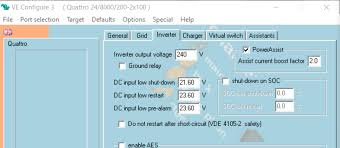parker-lhe
New Member
Hello! New here but have experience building automotive and solar based electrical systems. This is an interesting problem and I am hoping someone here has run across this or can point me where to start looking next.
My system is a RV based. Offgrid with shore power hookups. I have a eg4 3000 AIO with 2 lithium 48V 5.12kw batteries. Solar is 6 550W Renogy panels wired in series, roof mounted on a custom rack. The frames of the solar panels are connected to the frame/chassis of the RV by the nature of the roof rack. This is confirmed with a continuity meter.
I am working on setting up a way to charge the batteries from the engine via an auxiliary alternator. The aux alternator goes to its own 12V Lead acid bank. This system shares ground with the chassis so it is not isolated. I have a Renogy 3000W inverter hooked up to this 12V lead acid bank. The output of the Renogy 120VAC is hooked into the A/C input side of the eg4 3000 via a selector switch. I can switch between the shore power or the on board inverter that is powered by the engine is the gist of it.
Now when I turn on the Renogy inverter it powers up fine and outputs the 120VAC. When I attach the eg4 A/C input to the output of the Renogy inverter the inverter throws a GF error. Without attaching the eg4 to the output I can plug in tools and devices into the output of the inverter just fine and use them.
When I am on shore power the GFCI on the pole doesnt trip. So something about the inverter being connected on the DC negative side to chassis is causing some leakage to trip the internal GF on the inverter.
Now when I disconnect my PV array from the eg4 this does not happen. The inverter / engine can power the eg4 and charge the lithium batteries just fine.
I tested the PV+ and PV- and both are isolated from the frame / chassis when disconnected. Doing some reading these AIOs do leak current between the PV and A/C side.
What should be my next steps to get this working? It looks pretty easy to disable the GF detection on the Renogy inverter but I don't think that is the "best" method of solving this. I want to make sure I am not overlooking something.
Thanks!
My system is a RV based. Offgrid with shore power hookups. I have a eg4 3000 AIO with 2 lithium 48V 5.12kw batteries. Solar is 6 550W Renogy panels wired in series, roof mounted on a custom rack. The frames of the solar panels are connected to the frame/chassis of the RV by the nature of the roof rack. This is confirmed with a continuity meter.
I am working on setting up a way to charge the batteries from the engine via an auxiliary alternator. The aux alternator goes to its own 12V Lead acid bank. This system shares ground with the chassis so it is not isolated. I have a Renogy 3000W inverter hooked up to this 12V lead acid bank. The output of the Renogy 120VAC is hooked into the A/C input side of the eg4 3000 via a selector switch. I can switch between the shore power or the on board inverter that is powered by the engine is the gist of it.
Now when I turn on the Renogy inverter it powers up fine and outputs the 120VAC. When I attach the eg4 A/C input to the output of the Renogy inverter the inverter throws a GF error. Without attaching the eg4 to the output I can plug in tools and devices into the output of the inverter just fine and use them.
When I am on shore power the GFCI on the pole doesnt trip. So something about the inverter being connected on the DC negative side to chassis is causing some leakage to trip the internal GF on the inverter.
Now when I disconnect my PV array from the eg4 this does not happen. The inverter / engine can power the eg4 and charge the lithium batteries just fine.
I tested the PV+ and PV- and both are isolated from the frame / chassis when disconnected. Doing some reading these AIOs do leak current between the PV and A/C side.
What should be my next steps to get this working? It looks pretty easy to disable the GF detection on the Renogy inverter but I don't think that is the "best" method of solving this. I want to make sure I am not overlooking something.
Thanks!



